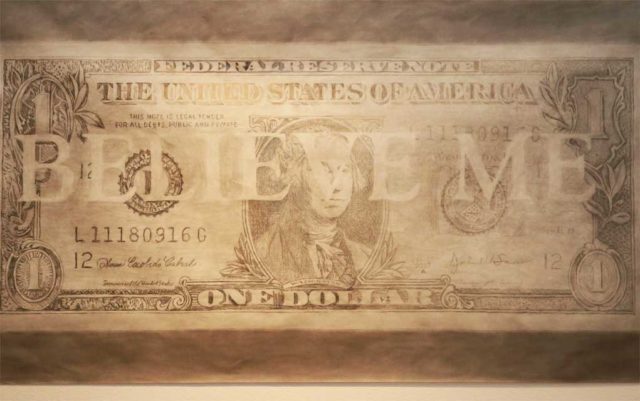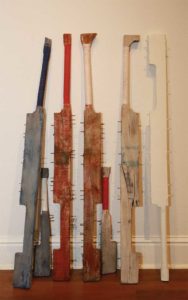
Over the past several months, the current state of politics has left many dejected. It’s a feeling that weighed heavily on Firehouse Art Center curator Jessica Kooiman Parker.
“I was feeling powerless and frustrated, literally just thinking, ‘What can I do to help people feel better about the political climate?’” Parker says. “I think all of us are thinking that: What can I do? I can go to a march, or I can write my congressman. For artists, what’s great is they can reflect back and create a piece that viewers can go see and connect with.”
But when she looked at the walls of her home and the art she collected, she felt everything was too beautiful. She wanted art that had a message — ugly art for an ugly world. So she reached out to local artists and asked them to use their work to react to the current political state, and the result is Modern America, now showing at the Firehouse through July 30.
“I want this to slap people in the face, I want it to scream at people, or it can even quietly reflect,” Parker says. “I want the artist and the viewer to feel really passionate about it.”
Parker started with asking the artists questions: Do you believe in something enough that you are willing to fight for it? What do you stand for? What are you ashamed of? What are you proud of?
The artists came back with varying answers. Some tackled issues of environment, feminism and greed, while others explored hoarding, selfie culture, the frustration of failed promises and even TSA pat downs.
Along with analyzing various facets of American life, the show also questions the role of the artist in responding to politics. Parker says artists have the opportunity to reflect society back to the audience and create work that forges connections. And many of the artists agree.

“I believe artists have a responsibility to represent the concerns of the people, whatever that may mean,” says Libby Barbee, one of the artists in the show. “Art is one of the few languages through which we can talk — really talk — about these big issues.”
Barbee is not new to blending politics into her art. The underlying theme she works with is examining humanity’s relationship with the natural world. In Modern America, Barbee’s piece “Sanguinaria” showcases wells, fire explosions and flowers blended together in saturated colors to create a sort of hyper reality.
She links fracking and natural gas extraction with bloodwood, a North America plant used by Native Americans that was later peddled by snake oil salesmen as a miracle drug.
“I was interested in using this plant that was being sold as medicine but was actually really poisonous, and the analogy of that to natural gas as being this fuel that’s going to be this interim savior from coal and dirtier fuels, but that is in fact equally terrible,” she says.
With the invitation from Parker to be overtly political, Barbee wanted to show the misuse and abuse of our landscapes. In “Sanguinaria,” she stresses that we’re facing a critical moment with the environment.
“In the next 15 years we need to get ourselves off fossil fuels if we’re going to be able to continue as a species,” she says. “We’re in decade zero; I think we’re very much in denial about that. And the Trump administration is unfortunate timing in that we need to be making some huge moves right now. The damage that is done in the next few years may be irrevocable.”
While Barbee’s piece is the only one in Modern America that deals hands-on with global warming, others reference the environment as one of the many casualties of the current state of the country.

“There’s a violence in the air in modern America, via language or what you see in the news, whether it’s live video or taking health care away from tens of millions of Americans,” says artist Clay Hawkley. “There’s direct and indirect violence. Climate change, the environment, the destruction of those things, is a slower violence on the world and ourselves.”
Hawkley frequently tackles politics in his work. In Modern America, he showcases multiple pieces, from a display of deflated balloons in “Hot Air” to a drawing of a dollar bill imprinted with the words “Believe me,” a popular phrase for our commander-in-chief.
But perhaps Hawkley’s most haunting work is “Big Sticks,” a set of seven wooden bats, painted red, white and blue and covered with nails jutting out from all sides. Leaning against the gallery wall, “Big Sticks” addresses the elephant in the room.
“I’m not a violent person, but it feels like there are new potentials for violence. We have a greater capacity for it now more than ever,” he says. “Things can escalate really quickly, and they have.
Having those bats in the gallery, they could be picked up at any time and be used against somebody in that space. I certainly don’t expect that or want to encourage that in any way, but that threat is on a lot of people’s minds, certainly on mine.”
Hawkley believes it’s art’s job to initiate dialogue and get people to think in nontraditional ways to stimulate growth and new perspectives.
“[Art] gives you the right to think freely and act freely and be offensive. That’s the beauty of it,” he says. “It’s an artist’s responsibility to call it as I see it. That doesn’t mean you’re necessarily going to agree with me or your neighbor, but I think it’s as important now as it’s ever been to get outside of your own head, to let something plant a seed and maybe get you thinking in a different way. Art is a great place to do that.”
For her painting “Nevertheless She Persisted,” Cindy Sepucha chose one of the most iconic symbols of America: the Statue of Liberty. To avoid its almost-clichéd imagery, she opted to paint it from a different perspective: from inside the flame.
At first glance, the painting looks dismal, almost as if Lady Liberty is melting or fading away. But the work offers hope for America’s future, Sepucha says.

“The artist who created the statue wanted to make a lighthouse, and the purpose of a lighthouse is to guide people through a storm to safe land so they don’t hit anything,” Sepucha says. “And it’s not an acting lighthouse because it’s not in an area that needs one, but I liked that symbolism of the light being the guide and kind of a safety net.
“I wanted to show [the painting] from the perspective of that light, which is kind of like a symbol of all things good in the United States,” she continues. “You can see the faint glow coming from the bottom of the piece; it’s what I saw as the hope. I believe things are going to be OK, regardless of how we feel right now, because I believe in the people who live here and in humanity in general.”
Normally, Sepucha says, her work is more whimsical than political. But even before being asked to participate in Modern America, she felt the call to respond to the state of the world.
“As an artist and anybody who uses expression in their work, I think right now if you’re feeling angst about what’s going on, it’s important to share that in whatever way you use as your mode of expression,” she says.
These days, with such thick party lines drawn, it’s hard to step across the aisle and have an open-minded discussion. But Sepucha hopes Modern America can be a step in the right direction.
“I don’t necessarily think if you make art that’s anti-gun, you’re going to make an NRA member believe in stricter gun control,” she says. “But I do think that having this consistent conversation around things that are important to people is a way to continue the conversation on what is important to us as a society.”
As curator, Parker wants the show to serve as not only a conversation starter, but also as a reminder of the strength of community.
“The thing that comforts me is knowing that we’re all in this together,” Parker says. “And so seeing all the artists with all their different perspectives feels to me like a good way to bring us back together.”
With Parker’s idea of “ugly art for an ugly world,” she wants the show to galvanize the viewer to fight for the future.
“There’s a lot of frustration, animosity and anger, but at the end of the day there’s some hope that it will get better, especially if we do it together and we’re conscious about it,” she says. “We so easily get lost in our day-to-day life and we let it go. Let’s not forget that it’s happening, and let’s do something about it.”
On the Bill: Modern America. Firehouse Art Center, 667 Fourth Ave., Longmont, 303-651-2787. Through July 30.














